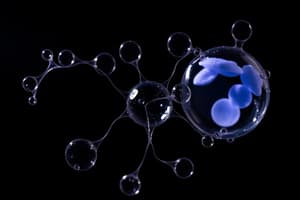Podcast
Questions and Answers
What is the main function of organelles in cell division?
What is the main function of organelles in cell division?
- To ensure proper separation of chromosomes (correct)
- To facilitate cell signaling
- To replicate DNA
- To synthesize proteins
Meiosis results in four identical daughter cells.
Meiosis results in four identical daughter cells.
False (B)
What is the main difference between mitosis and meiosis?
What is the main difference between mitosis and meiosis?
Mitosis results in two identical daughter cells, while meiosis results in four non-identical daughter cells.
The process of cell division that results in four non-identical daughter cells is called __________.
The process of cell division that results in four non-identical daughter cells is called __________.
Match the following terms with their definitions:
Match the following terms with their definitions:
Sister chromatids are identical copies of a chromosome.
Sister chromatids are identical copies of a chromosome.
What is the term for the physical expression of a gene?
What is the term for the physical expression of a gene?
What is the purpose of a Punnett Square?
What is the purpose of a Punnett Square?
What is the primary reason for cells to undergo reproduction?
What is the primary reason for cells to undergo reproduction?
Asexual reproduction results in genetically identical offspring.
Asexual reproduction results in genetically identical offspring.
What is the term for the process of cell division that results in four non-identical daughter cells?
What is the term for the process of cell division that results in four non-identical daughter cells?
During _______________, the chromatin condenses into visible chromosomes.
During _______________, the chromatin condenses into visible chromosomes.
What is the purpose of crossing over in meiosis?
What is the purpose of crossing over in meiosis?
Homozygous traits have two different alleles.
Homozygous traits have two different alleles.
Match the following reproductive system parts with their functions:
Match the following reproductive system parts with their functions:
What is the term for the genetic makeup of an organism?
What is the term for the genetic makeup of an organism?
Flashcards are hidden until you start studying
Study Notes
Cell Reproduction
- Cells reproduce to grow, repair, and reproduce themselves.
- Organelles play crucial roles in cell division, particularly during mitosis.
- Mitosis consists of six phases: Interphase, Prophase, Metaphase, Anaphase, Telophase, and Cytokinesis (IPMATC).
DNA Structure
- During the cell cycle, DNA exists in a condensed chromatin state, which becomes more condensed into chromosomes during mitosis.
- Chromatin is the uncoiled, thread-like structure of DNA, while chromosomes are the coiled structures visible during mitosis.
Types of Reproduction
- Asexual reproduction involves the production of offspring with identical genetic material, occurring through two types: binary fission and budding.
- Sexual reproduction involves the fusion of gametes to form offspring with unique genetic material, having advantages and disadvantages compared to asexual reproduction.
- Meiosis consists of two successive cell divisions, resulting in four haploid gametes, with Prophase I featuring crossing over.
Chromosomes
- Mitosis produces diploid body cells with a full set of chromosomes, while meiosis produces haploid gametes with half the number of chromosomes.
- Human body cells have 46 chromosomes, while gametes have 23.
- Sister chromatids are identical replicas of chromosomes that are joined at the centromere.
Male and Female Reproductive Systems
- The male reproductive system consists of organs such as testes, epididymis, vas deferens, and penis.
- The female reproductive system consists of organs such as ovaries, fallopian tubes, uterus, and vagina, with ovulation, fertilization, and menstruation occurring.
- Unfertilized eggs are disposed of through menstruation.
Genetic Traits
- Heterozygous traits have two different alleles, while homozygous traits have two identical alleles.
- The sex of a fetus is determined by the presence of XX or XY chromosomes.
- Dominant genes are expressed when paired with recessive genes, while recessive genes are only expressed when paired with another recessive gene.
- Phenotype refers to the physical expression of a trait, while genotype refers to the genetic makeup of an individual.
Genetic Problem Solving
- Punnett Squares are used to predict the probability of offspring traits by combining parental genotypes.
Cell Reproduction
- Cells reproduce for growth, repair, and reproduction
- Organelles have specific functions in cell division, focusing on mitosis
Phases of Mitosis
- Interphase: cell grows and prepares for division
- Prophase: chromatin condenses into visible chromosomes
- Metaphase: chromosomes line up at the center of the cell
- Anaphase: sister chromatids separate and move to opposite poles
- Telophase: nuclear envelope reforms and chromosomes uncoil into chromatin
- Cytokinesis: cytoplasm divides and cells split
DNA Structure
- Chromatin: DNA wrapped around histone proteins
- Chromosome: condensed chromatin visible during mitosis
Types of Reproduction
- Asexual reproduction: produces genetically identical offspring, two types: binary fission and budding
- Sexual reproduction: produces genetically diverse offspring
- Advantages of sexual reproduction: increased genetic diversity, adaptation to environment
- Disadvantages of sexual reproduction: requires two parents, offspring may not inherit beneficial traits
Meiosis
- Phases: Interphase, Prophase I (crossing over), Metaphase I, Anaphase I, Telophase I, Cytokinesis
- Creates four genetically unique sex cells (gametes)
Chromosomes
- Mitosis: body cells have full set of chromosomes
- Meiosis: sex cells (gametes) have half the number of chromosomes (23 in humans)
- Sister chromatids: identical copies of DNA before separation during mitosis and meiosis
Male and Female Reproductive Systems
- Male reproductive system: produces and transports sperm
- Female reproductive system: produces eggs, ovulation, fertilization, and menstruation
- Unfertilized eggs are released from the body during menstruation
Genetic Traits
- Heterozygous: two different alleles for a trait (e.g., Bb)
- Homozygous: two identical alleles for a trait (e.g., BB or bb)
- Symbolic representation: capital letters for dominant alleles, lowercase letters for recessive alleles
- Determining fetal sex: XX for female, XY for male
Genetic Problem Solving
- Punnett Squares: a tool to predict offspring traits and determine probability of certain characteristics
Studying That Suits You
Use AI to generate personalized quizzes and flashcards to suit your learning preferences.




